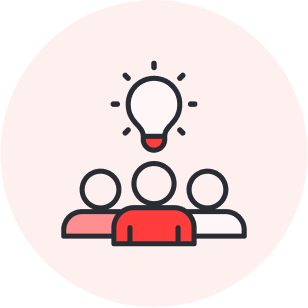Imagine for a moment that you’re on a team in charge of developing a landing page for your newest product. The meeting is set, the team gathers, and the brainstorming begins. Each member of the team takes diligent notes and comes away from the meeting fairly confident about next steps. But at the next progress meeting, each member of the team presents their tasks, and they’re not aligned. It seems that each member of the team has wildly different interpretations of the previous meeting, and the project is suddenly off track.
This is a common business scenario, but it doesn’t need to be. Digital whiteboarding unifies and clarifies projects, and it’s not just for remote teams: the same processes that apply to making remote groups cohesive should apply for in-person teams. Every type of group can benefit from solutions that visualize and preserve ideas, which is why digital whiteboarding can be so helpful.
Here are 10 compelling reasons why digital whiteboarding is about to become your new best brainstorming friend.
1. It drives engagement from every meeting participant
Online whiteboards make participation compulsory. After all, it’s obvious when members of the group aren’t participating because everyone’s looking at the same software, so it’s not as easy to opt out of contributing.
During in-person meetings, some members of the group might dominate the conversation and other members might mentally check out of the meeting altogether. Using a digital whiteboard solves that. Each member of the team can have their own color, so it’s immediately apparent which contributions are made by each person.
Lucidspark’s collaborator colors make this easy—each collaborator will be assigned a color, which styles their icon, cursor, freehand drawing, and sticky notes. It makes for a more equitable experience, which means all voices are encouraged to participate.
2. It creates a single source of truth
In the scenario above, each participant had their own interpretation of the landing page. That led to disparate understandings of the finished product. A digital whiteboard ends the confusion. Instead of having each person make their own notes, a digital whiteboard creates a single record. The finished product stems from the same source, which means everyone is on the same page throughout the project.
3. It’s much easier to share
The solution for most in-person meetings is to either have everyone take their own notes, assign a notetaker for the group, or just keep notes on a stack of sticky notes that are then written up and sent by email to the group. Each of those methods is problematic and inefficient.
A digital whiteboard, on the other hand, is accessible to everyone instantly and updates in real time. This alleviates the responsibility from a single note taker who may interpret something in the meeting incorrectly or omit an important point. And a digital whiteboard can be accessed on myriad devices, which is great when notes need to be accessed while traveling.
4. It allows for versioning
Manual whiteboarding is static. As the product evolves, it’s difficult—and often impossible—to consult previous versions of brainstorming sessions or wireframe versions or initial ideas. That means value can be lost as the project progresses. But a cloud-based whiteboard allows for ongoing documentation and the preservation of version after version, making it easy to consult previous iterations and carry certain elements from version to version. Your workspace becomes organic documentation without any additional steps as you take notes and leave thoughts, comments, and next steps.
5. It prevents disasters
Picture this: Your team has just completed a stellar brainstorming meeting for your new project name. The ideas were genius, and they’re all there on the whiteboard in the main meeting room. The VP of Marketing says she’ll take a picture of the whiteboard and send it to everyone. But she forgets to take the picture. And the next team in the meeting room erases your ideas.
It’s an all-too-common scenario, and it’s easily prevented with a virtual whiteboard. A cloud-based whiteboard can’t be deleted easily, and if it is accidentally deleted, it can simply be recovered.
6. It allows for participation from remote team members
It’s likely your team consists of remote team members, and those remote teammates usually have a more difficult time participating in meetings. But visual collaboration through digital whiteboarding unites teams, wherever they’re working. Everyone has an equal chance to contribute to the board and connect with the team. When all of your work is digital, you don’t have to worry about filling in remote or hybrid workers on what they missed—because they don’t miss anything in the first place.
7. It makes soliciting feedback much easier
Gathering buy-in from stakeholders is difficult when they can’t immediately understand what the team is talking about. They can’t visualize wireframes or processes from meeting notes alone, and they’re more hesitant to approve something that’s been cobbled together from sticky notes. And when they need to provide feedback on what the team has proposed, they are left to email threads or verbal feedback that can be unclear and difficult to share.
With a digital whiteboard, stakeholders are given a link to the whiteboard itself. They can easily comment on any aspect of the whiteboard, and tasks can be assigned from that feedback within the whiteboard. It’s a clear process that makes everyone’s job easier.
8. It makes task management easier
After an in-person whiteboarding session, it’s often up to a project manager to assign tasks. In lieu of a project manager, team leaders usually assign tasks through email after the meeting, which is an inefficient means of handling next steps. Worse, tasks can not be assigned at all, and all the ideas generated in brainstorming never go anywhere.
A digital whiteboard prevents next steps from being forgotten. Team members can be tagged within the virtual whiteboard so they know what to work on, and responsibility is shared with the entire team instead of relying on a single person to distribute tasks. Digital whiteboards keep the process moving. There’s no question of what next steps are and where the team is headed next.
9. It increases a sense of ownership
When everyone has contributed to a meeting and there’s immediate, visual proof of that contribution, team members are more likely to take ownership of, and pride in, a project. They’re invested because they feel they’ve contributed to the task—and everyone else can see those contributions thanks to every team member having their own color on the digital whiteboard. That simply doesn’t happen when one person is in charge of writing everything down. Ownership can be a powerful catalyst for generating great ideas and providing momentum throughout the duration of the project.
Virtual whiteboarding is the solution for the future of collaboration. It’s an inclusive way to gather feedback, solicit buy-in, assign tasks, and increase ownership among team members. If there’s confusion, it’s easy to consult the whiteboard, and it’s much easier to make sure everyone’s on the same page when they’re looking at the same thing.
10. It improves meeting facilitation
Meetings are too often unfocused and unproductive. Whether in-person, remote, or hybrid, a virtual whiteboard can help leaders facilitate discussion, drive the meeting forward, and keep attendees engaged—no matter where they’re working from.
Lucid’s Facilitator Tools enable teams to collaborate on a shared virtual whiteboard with special features to support successful meetings, including:
- Broadcast: Send an announcement to an entire group
- Laser pointer: A virtual pointer to draw attention to specific areas on the board
- Take the lead: Participants will automatically follow you around the board when presenting or demonstrating
Virtual whiteboarding is the solution for the future of collaboration. It’s an inclusive way to gather feedback, solicit buy-in, assign tasks, and increase ownership among team members. If there’s confusion, it’s easy to consult the whiteboard, and it’s much easier to make sure everyone’s on the same page when they’re looking at the same thing.
Whether you’re in the office or working from home, virtual whiteboarding can bring your team together and deliver better results.

Explore 5 reasons why your team definitely needs collaboration software.
Get startedAbout Lucidspark
Lucidspark, a cloud-based virtual whiteboard, is a core component of Lucid Software's Visual Collaboration Suite. This cutting-edge digital canvas brings teams together to brainstorm, collaborate, and consolidate collective thinking into actionable next steps—all in real time. Lucid is proud to serve top businesses around the world, including customers such as Google, GE, and NBC Universal, and 99% of the Fortune 500. Lucid partners with industry leaders, including Google, Atlassian, and Microsoft. Since its founding, Lucid has received numerous awards for its products, business, and workplace culture. For more information, visit lucidspark.com.
Related articles
Best team collaboration tools
Let’s take a look at some of the best-of-breed collaboration tools to meet all of your team's collaborative needs.
Virtual meeting challenges and how to overcome them
In this blog post, we will review virtual meeting challenges and discuss solutions to overcoming them.
Collaboration software 101
In this article, we’ll explore the process of choosing the right collaboration software to create a more efficient, cohesive team environment.
How to choose new software with Lucidspark
Let’s walk through how to use Lucidspark to analyze and choose new software in a systematic and collaborative way.

